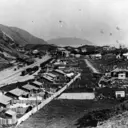Paekākāriki Town
Beach Road, Paekākāriki
Paekākāriki (the perching place of the green parakeet) is the gateway from Wellington to the coastal lowlands, a place where travellers have always paused for rest and refreshment.
The coastal track from Pukerua Bay was the travelling route for Māori, missionaries, traders and from 1840, settlers and mail carriers. The first cattle for Whanganui were driven through in 1841.
Signs of early settlement include a 400-year-old moa-hunter camp in the dunes, and pits on the ridge above the town indicating food stores and house sites.
In the 1820s Ngāti Toa established Wainui Pā at the mouth of Wainui Stream. A smaller Te Āti Awa pā, Paripari, was a kilometre south of this site, and Whareroa by a stream to the north.
The government bought the large Wainui and Whareroa land blocks in 1858. In the 1860s the Smith, MacKay and Lynch families farmed much of this land.
After the Hutt Valley War of 1846, the 58th Regiment built the Paekākāriki Hill Road from Horokiwi Valley for both civilian and military traffic. It would be the main road north until 1939.
Whaler ‘Scotch Jock’ Nicoll and his wife, Kahe Te Rau-o-te-Rangi, opened an accommodation house at Paripari, moving to Paekākāriki in 1847.
A scheduled coach service via the Paekākāriki Hill Road began in 1865. Draught horses were used for the hill section but changed to faster teams at the hotel changing stables.
The Wellington and Manawatu Railway Company line opened in 1886. Wellington crews drove heavy tank engines to Paekākāriki, where new crews took the trains on to Longburn. The town grew rapidly, acquiring a school, churches and other facilities. The railway allowed city people to stay at this growing holiday resort.
Between the wars the hill road was realigned for growing motor traffic and a tearoom opened at the summit.
In the late 1930s, Centennial Highway was built along the foreshore. Opened in 1939, it became the main highway north.
During the Second World War, 15,000 U.S. Marines disembarked at the station for camps situated at Whareroa Farm, Queen Elizabeth Park and north Paekākāriki. Their impact of their presence in 1942/43 was huge, and in some ways has carried through to the present day.
Since 1945, electric units have taken commuters to work in the city. New subdivisions doubled the town’s population. The goods shed built to service the American camps became the packaging centre for a Bristol freighter service from Paraparaumu airport to the South Island.
The railway station now houses a local museum. Steam engines are restored and operated from the Steam Incorporated depot.

